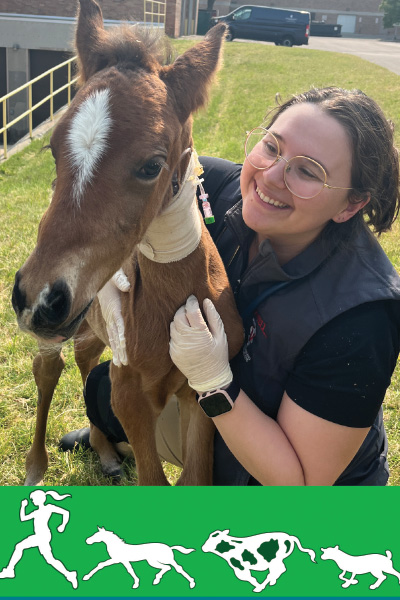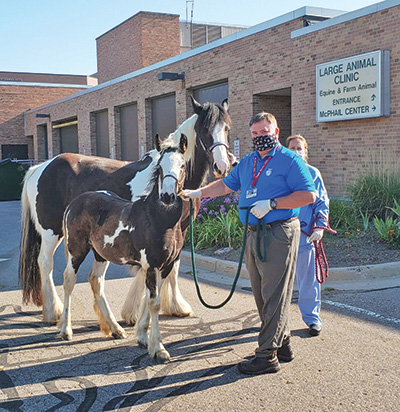

“A little ‘off’ is a big problem when it’s a foal.”
The words of Dr. Lauren Bookbinder, assistant professor of Large Animal Clinical Sciences, doubtless ring loudly to equine veterinarians worldwide. Small signs of maladjustment in delicate neonates can rapidly spiral into life-threatening sepsis, making it critical for equine practitioners to think on their feet when presented with an “off” foal.

Big Babies
Every year, the Hospital holds the Big Babies 5K to raise money to offset the hospitalization expenses of newborn large animals. The event honors the memory of Dr. Annie Kullmann, a former MSU resident from South Africa, whose research investigated if seizures in dummy foals affected their long-term prognosis.
Most foals requiring critical care at MSU are those who demonstrate maladjustment to extrauterine life. This is often called neonatal maladjustment syndrome, or “dummy” syndrome, in foals. These signs are first caught on the farm.
“One of the things owners tell us that gets us worried is when they say the foal is ‘sleepy’ or ‘lazy,’ explains Bookbinder. “Those adjectives don’t really apply to animals. When an adult horse is subtly ‘off,’ sometimes you can closely observe for a few hours. But it’s critical that these signs are assessed quickly in foals.”
These signs often include an inability to nurse, which means the newborns do not get adequate nutrition or the immune-boosting benefits of colostrum, putting them at risk of a bacterial infection and sepsis. These foals may also struggle to stand on their own or cannot urinate or defecate properly.
Dr. Hal Schott, professor of Large Animal Clinical Sciences, describes the “Rule of 1-2-3” for assessing neonates.
“Within one hour, the foal should stand,” he says. “Within two hours, it should nurse. And by three hours, the placenta should pass. When foals don’t reach these milestones, we strongly recommend early intervention.”

While mild cases can sometimes be managed on the farm, referral to a veterinary hospital should always be discussed because foals can deteriorate rapidly if they are not nursing adequately.
“Foals typically do better if they can come into a hospital environment, where they can get continuous nutrition and IV antibiotics,” says Bookbinder.
“Early referral is key for success,” stresses Dr. Ana Moreira, assistant professor of Large Animal Clinical Sciences. “Owners and referring veterinarians should avoid a ‘wait-and-see’ approach, because usually that means the foal will be in worse condition, and thus require longer hospitalization.”
Newborn foals at the MSU Veterinary Medical Center are closely monitored day and night by clinicians and veterinary nurses. The Hospital is the only facility in Michigan that has 24/7 nursing care for the administration of fluids, nutritional support, plasma, and antibiotics to mitigate the risk of sepsis. Veterinary students even volunteer for foal team each spring to assist with this care.
“Round-the-clock care is paramount in critically ill foals,” says Moreira. “If they’re really sick, foals require turning every two hours because they can’t stand. Some will need oxygen support and IV fluid therapy, so they will have several IV fluid pumps attached to deliver the appropriate fluid rates. Someone needs to sit with them 24/7.”

At the MSU Veterinary Medical Center, multiple specialty services, surgeons, and equipment can be used to diagnose and treat a foal.
“We’re also the only place nearby that can do advanced imaging; like an MRI of the brain of a foal, or imaging of its entire body via a CT scan or MRI,” says Schott.
Foals treated for maladjustment syndrome, sepsis, and infectious conditions at MSU see a high rate of survival when referred at the first signs of disease.
“Foals that recover usually go on to live full lives,” says Schott. “It’s a rough start, but they end up doing okay.”
MSU has a rich history of foal-related research. Both Bookbinder and Moreira are continuing that trend with current investigations.
Bookbinder recently led a retrospective study evaluating how to best identify foals that are septic.
“The best way to currently identify foals that are septic, and what’s growing in their blood, is through blood culture,” she explains. By looking at 149 fluid samples from 133 foals, Bookbinder and her team examined the bacterial culture and sensitivity results from blood cultures in foals and compared this to empirical antibiotic treatments—basically assessing if commonly used antibiotics align with the bacteria species found in these cultures.
She and her colleagues are also investigating improvements to bacterial culture of blood samples that take two to three days to get initial results. “We’re looking into creating a PCR plate that would be faster and potentially more accurate,” she explains.
Moreira is also launching a research project to investigate the feasibility of a high-flow oxygen system in large animal neonates. The system provides high-flow, humidified oxygen at body temperature, so it’s more comfortable for the recipient.
“It has been used a lot in human hospitals for COVID as a step before a ventilator,” she says. “Because oxygen is given at such a high flow, it reduces the work of breathing, which reduces fatigue for the muscles and diaphragm.” If investigations into calves and foals show a reduction in the work of breathing like it has for humans and dogs, Moreira hopes to transition to using the high-flow system in hospitalized foals.